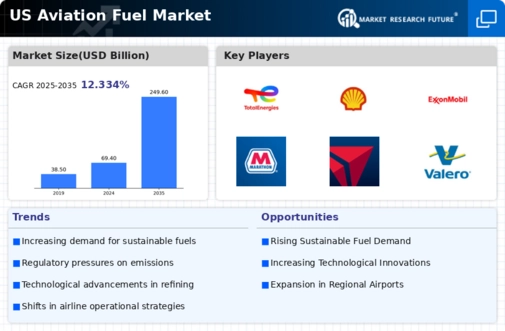The US Aviation Fuel Market is characterized by a diverse range of players contributing to its competitive dynamics. This sector has seen substantial growth and development, primarily driven by the increased demand for air travel and advancements in fuel technology. Companies operating in this market are strategically positioning themselves to capture a larger share of the market by leveraging their operational efficiency, logistics capabilities, and product innovation.
Competition in the aviation fuel industry is influenced by various factors such as fluctuating crude oil prices, regulatory changes, and the push towards sustainable fuels, creating a complex landscape where companies must navigate both challenges and opportunities. The relationships with airlines, airports, and service providers further define the competitive arena, with businesses striving to enhance customer satisfaction and service delivery in a sector where reliability and efficiency are paramount.TotalEnergies has established a notable presence in the US Aviation Fuel Market through its commitment to providing high-quality fuels and comprehensive aviation solutions.
The company's strength lies in its ability to integrate upstream and downstream operations, enabling it to deliver a steady supply of aviation fuel while ensuring strict adherence to safety and quality standards. TotalEnergies has invested significantly in infrastructure to support aviation fuel distribution, allowing it to reach a broad client base including major airlines and private operators. Additionally, the company is increasingly focusing on sustainability initiatives, developing alternative fuel options to meet the growing demand for environmentally friendly aviation fuel.
This positions TotalEnergies favorably in a market that is progressively leaning towards sustainable practices.Shell has a well-established foothold in the US Aviation Fuel Market, recognized for its extensive portfolio of aviation products and services. The company's key offerings include Jet A and Jet A-1 fuels, along with a range of performance-enhancing additives designed to improve fuel efficiency and reduce emissions. Shell's strengths stem from its robust supply chain, extensive distribution network, and commitment to innovation, which allows it to consistently meet the needs of a diverse clientele, including commercial airlines and business aviation operators.
The company has been actively involved in mergers and acquisitions to bolster its market presence and enhance its technological capabilities. Shell's ongoing investments in research and development are focused on pioneering sustainable aviation fuels, reflecting its strategy to adapt to the evolving demands of the aviation industry in the US.
























Leave a Comment